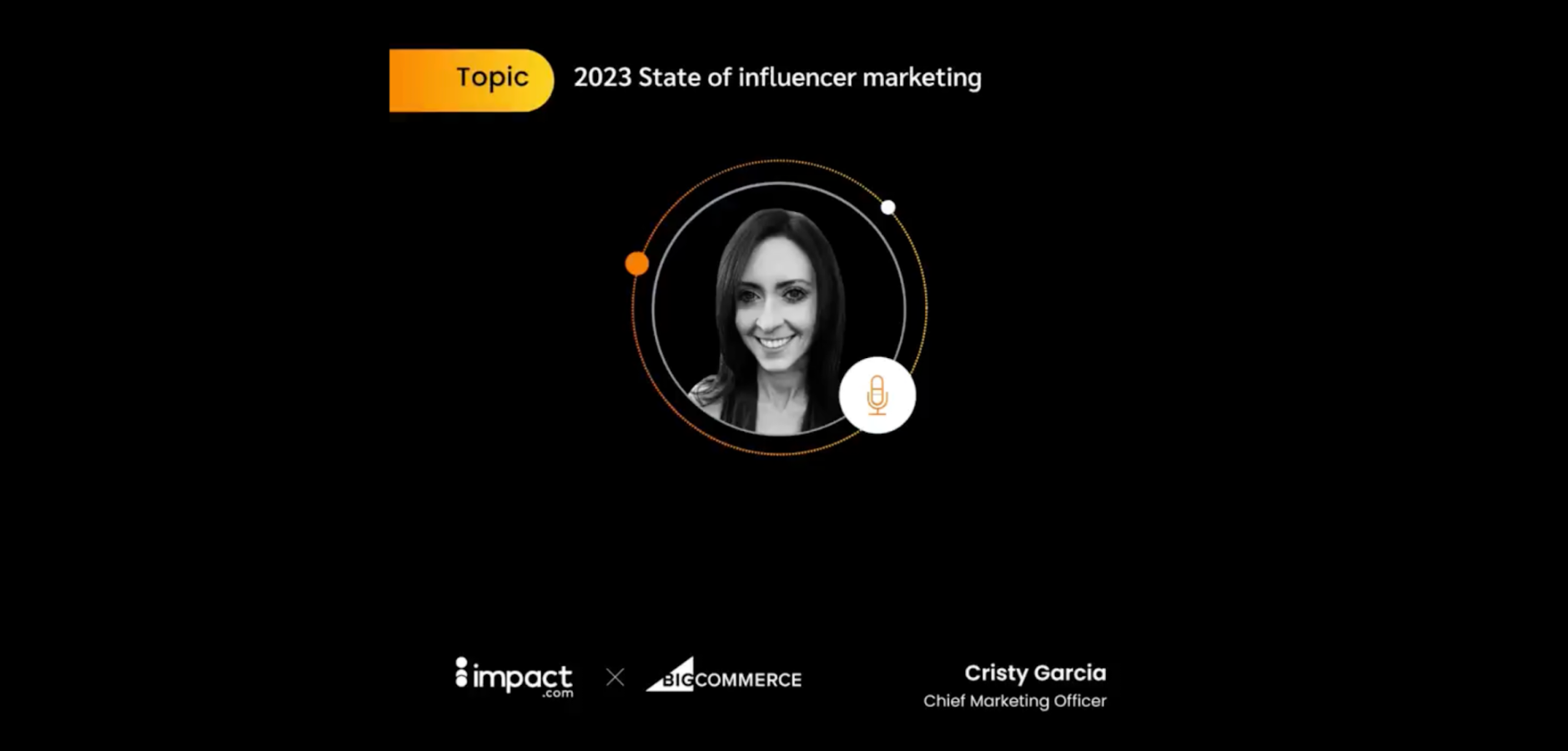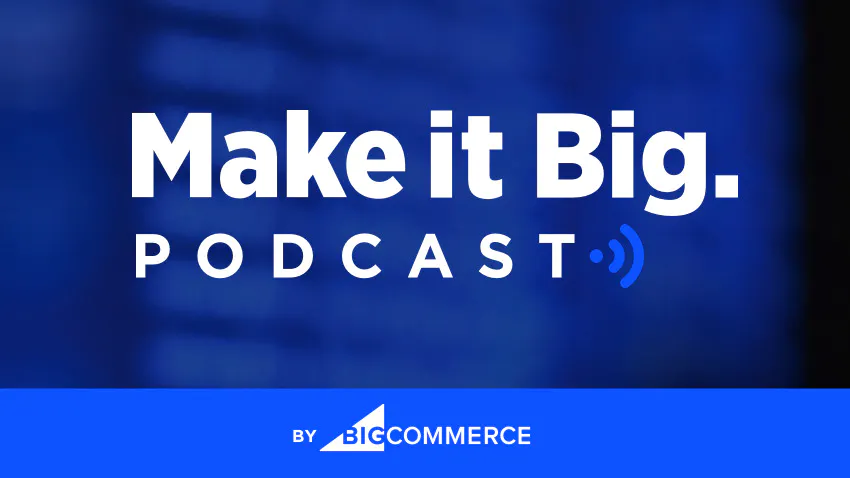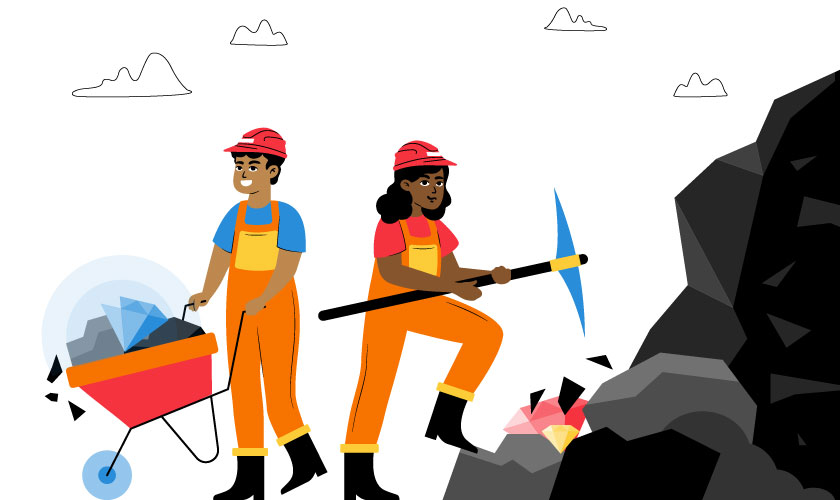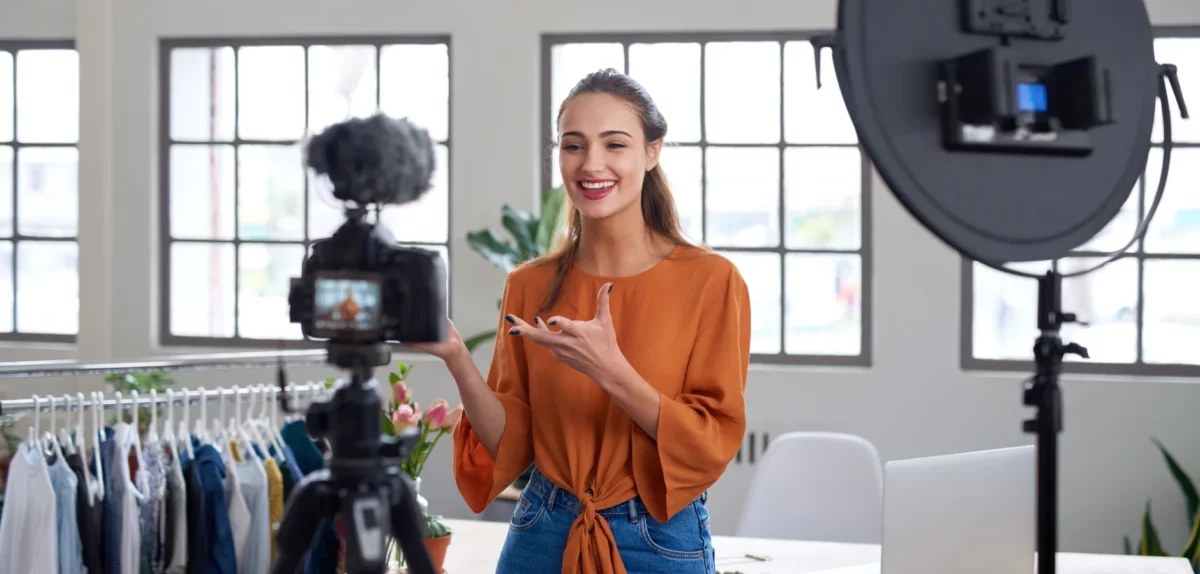From digital diaries to an integral part of any marketer’s playbook, influencer marketing continues to soar in popularity––it’s set to grow from $16.4 billion in 2022 to $21.1 billion in 2023.
During The COVID-19 pandemic, people were stuck at home and spent more time browsing social media, product recommendations, and other creator-led content. Live-streaming through TikTok replaced in-person shopping and provided a new way for shoppers to engage.
Plus, Partnership Management Platform like impact.com / creator made collaborating with influencers easier. It’s now simple to track every campaign’s results and return on investment (ROI). And with the rise of tech such as shoppable links, it’s easy to trace conversions back to the influencer.
Recently, Cristy Garcia, CMO of impact.com, spoke on BigCommerce’s State of Influencer Marketing podcast.
To enhance your current and future influencer marketing campaigns, read on to find out Cristy’s top tips and trend predictions.
Key takeaways:
- Audiences prefer authentic content from influencers as opposed to overly filtered posts
- Un-fluencing is when a creator gets influencer marketing wrong or misrepresents themselves or a brand.
- Artificial intelligence (AI) has benefits for influencer marketing, but it can’t replace human creativity.
- Long-term influencer partnerships have a greater chance of building consumer trust than short-term partnerships.
- B2B brands can benefit from influencer marketing as much as B2C brands if they partner with the right creators.
Un-influencing and why authenticity is key for success
While selecting creators and building campaigns, brands should ensure accidental un-fluencing doesn’t occur.
Un-fluencing is when a creator gets influencer marketing wrong or misrepresents themselves or a brand.
For example, an influencer posts on Instagram that they’re at a famous music festival. They invite followers to watch them get ready in Reels, post Stories of themselves in the desert, and tag brands in their outfit posts. But there’s one problem—they’re at home on their couch.
Someone calls them out, and suddenly audiences realize the content is fake. As a result, the engagement on their organic and paid sponsorship posts tanks. Followers can’t unsee the fakeness, and they’re no longer interested in engaging with any further content.
In the last few years, people have felt bombarded by ultra-polished, unattainable social media content. Now there’s a rise in people looking to engage with authentic, relatable content.
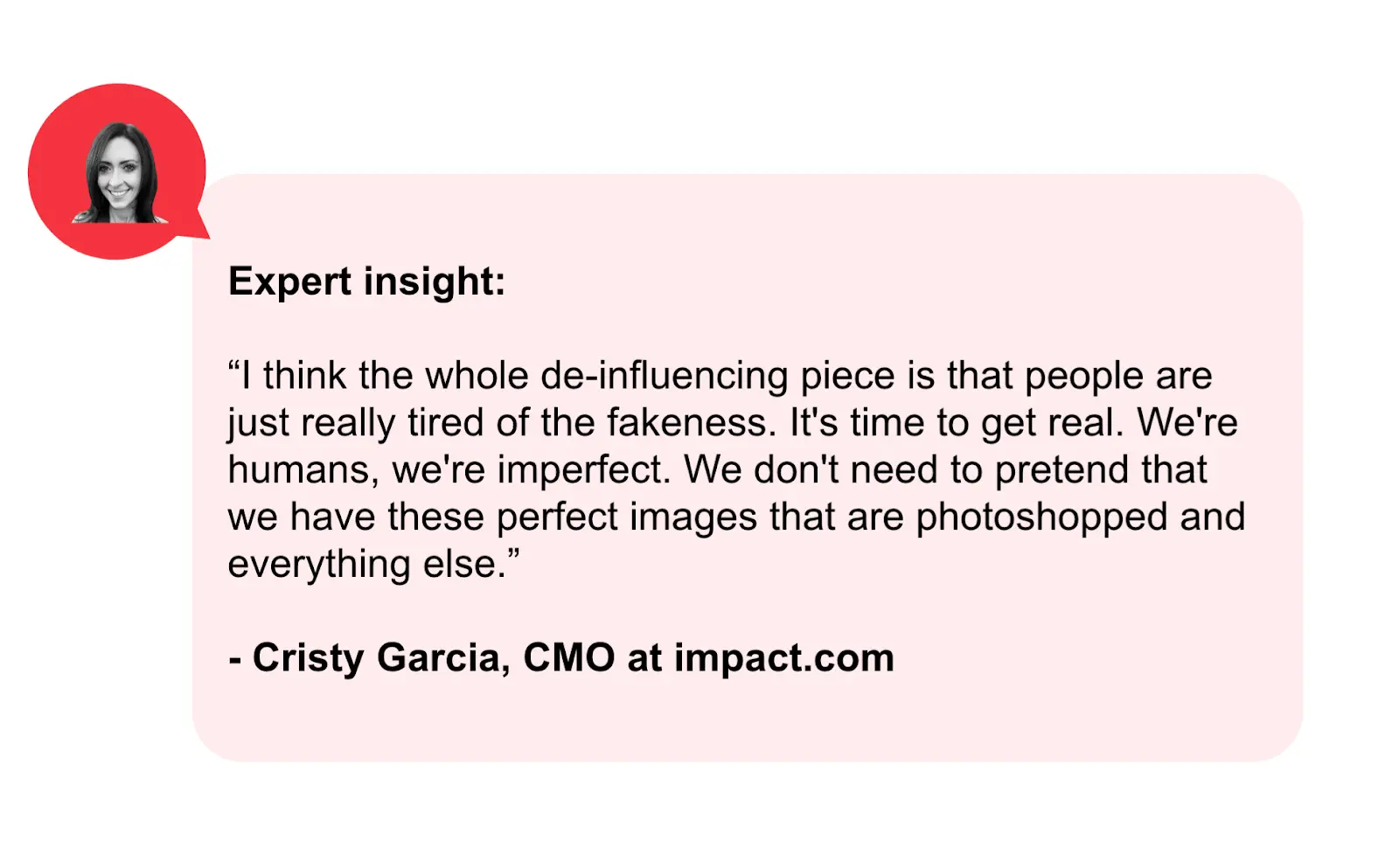
Authenticity is what often separates engaging and relevant influencer campaigns from ones that get passed over. People ultimately trust a consistent, familiar, and honest voice. When brands partner with authentic creators that match their values, they’re much more likely to achieve engagement and conversions.
Marketers must take care not to over-direct creators. It may seem counterintuitive, but allowing influencers to have creative freedom works in your favor. This allows the creator to build authentic and engaging stories around your product that resonate with their audience, whom they know and understand very well. After all, they built it!
A brand that did influencer authenticity right
Wine ordering app Vivino wanted to make wine discovery and purchase fun, accessible, and effortless for all wine lovers. The brand chose 10 diverse voices, from chefs and parents to wine experts. The aim was to show how Vivino helps everyone find the right wine based on their individual taste.
Using authentic-led influencer marketing campaigns, creators showed how easy it is to use the app and how delicious the wine is. The influencers are relaxed, happy, and having a good time in a way that puts the audience in the scene.
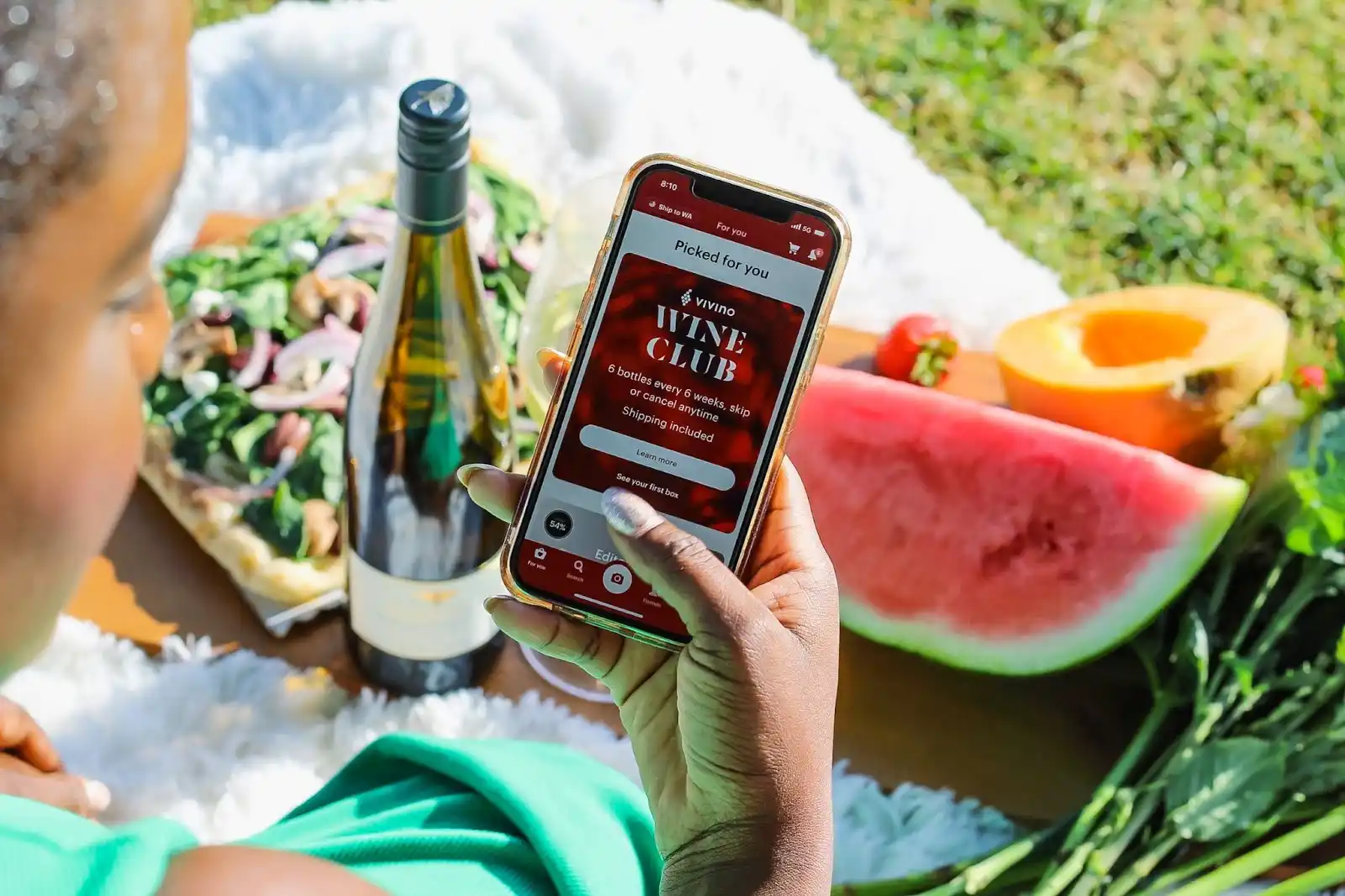
Source: Micro-influencer @by_lakeisha for Vivino

Source: Micro-influencer @by_lakeisha for Vivino
Thanks to the authentic and relatable creator content, Vivino achieved these incredible results:
- 1.36m post impressions
- 50.3k post engagements
- 11k+ post clicks
Track the full funnel for influencer marketing
By using the right technology, marketing managers can automate every stage of the influencer life cycle. What would take hours in research, contract management, and tracking can now take a few minutes or seconds.
Implementing the right tools is also key for measuring the success of your creator-led campaigns. Without effective tracking, it’s harder to understand the overall impact of working with creators.
A comprehensive Partnership Management Platform can help track every stage of the influencer life cycle:
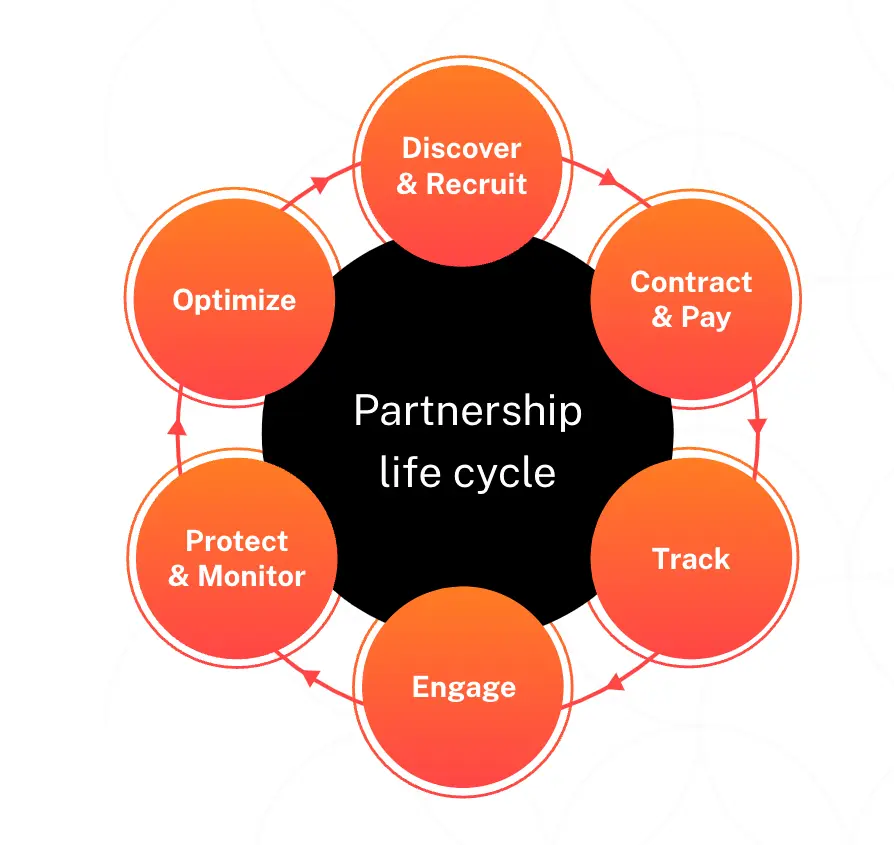
- Discover and recruit: Identify suitable creators on marketplaces like impact.com / creator.
- Contract and pay: Automate contracting and payouts according to customizable triggers.
- Track: Accurately attribute your campaign’s engagement and conversions.
- Engage: Set up messaging and workflows to ensure partners stay informed, productive, and on-brand.
- Protect and monitor: Identify fraud and any traffic abnormalities.
- Optimize: Review actionable data to optimize partnerships, driving growth and increasing efficiency.
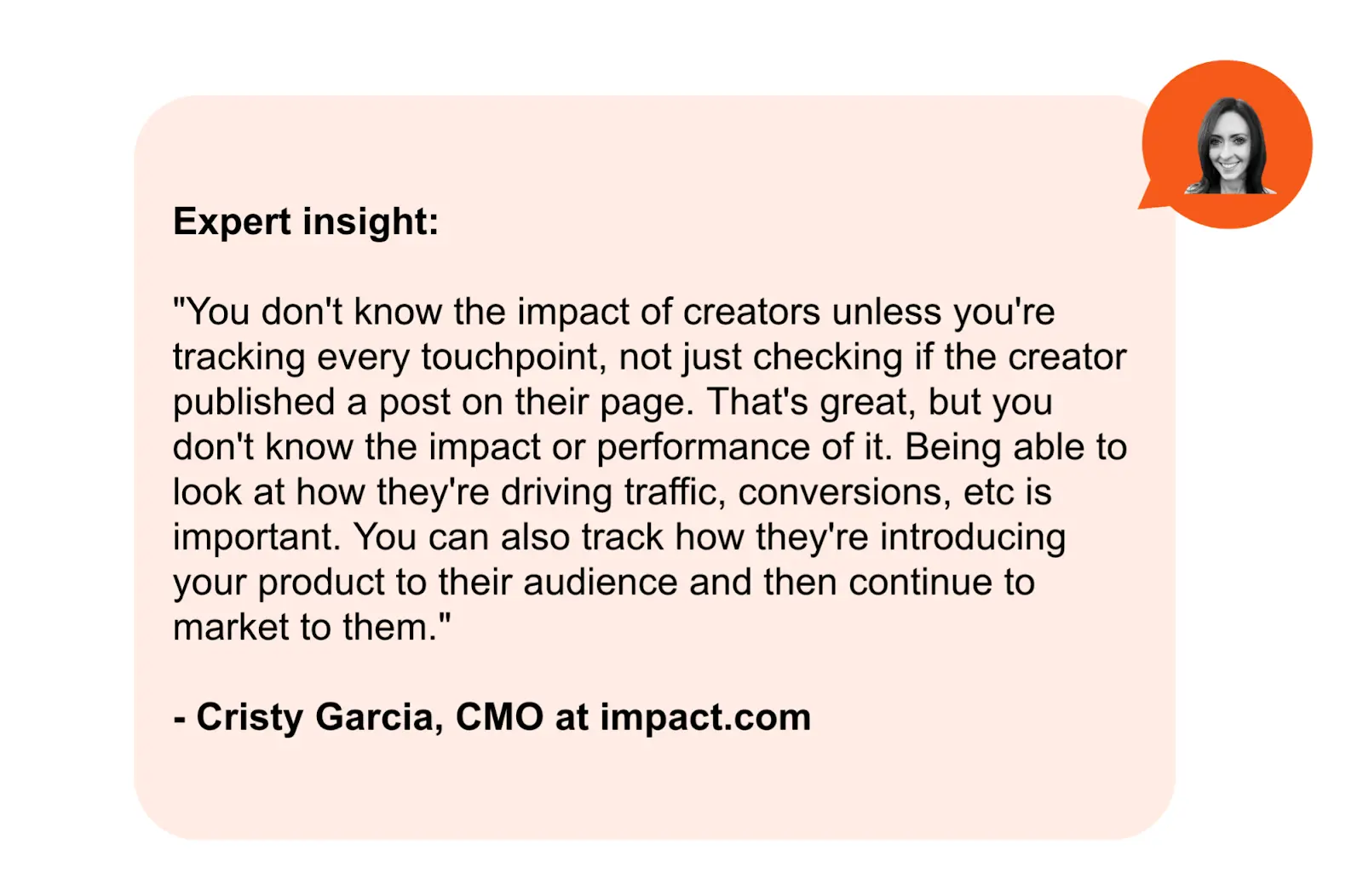
By using platforms like impact.com / creator to automate their influencer campaigns, marketers can save time and enjoy other benefits, including:
- Centralized data: Instead of using different tools and working with multiple KPIs, automation software collects your data in one place. Set organization-wide goals for things such as new creator acquisition or conversion rates of new partners.
- Save resources and money: Software lets marketers manage partner relationships consistently across the board, paying out once per partner and avoiding issues that arise from partner crossover. Avoid duplicating payouts, streamline workflows, and use reports for compliance.
- Build flexible contracts: Use automation to find groups of creators that are driving more new customers, then create contracts that incentivize growth in customer acquisition and conversions.
Check out the new impact / creator platform!
AI works for influencer marketing, but it can’t replace human connection
Artificial intelligence (AI) is the latest buzzword on every marketer’s lips. While it may lack some human touch for more creative tasks, AI can solve several challenges and streamline some processes associated with influencer marketing.
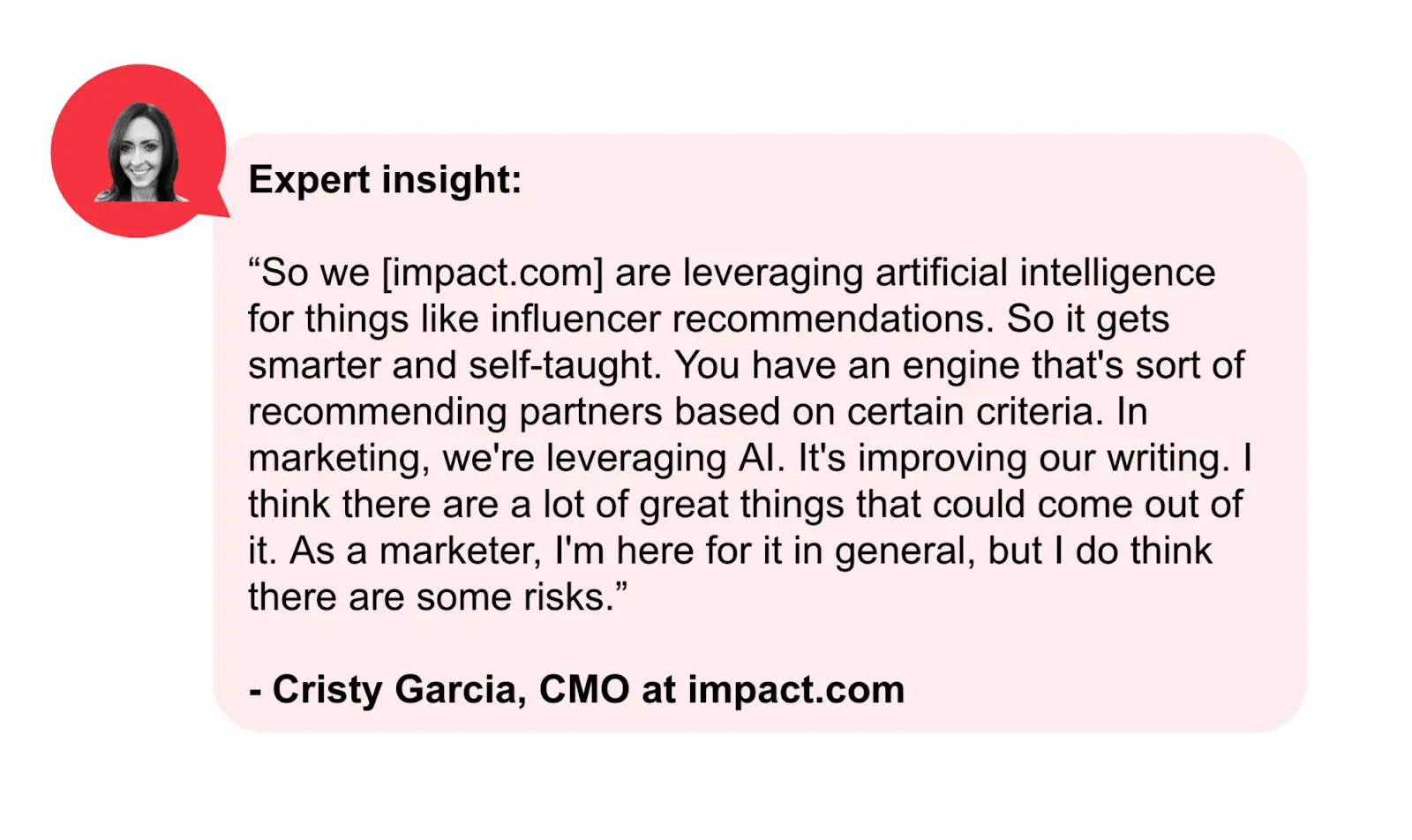
Here are some ways that AI technology can benefit your influencer campaigns:
- Finding the right influencers: AI tools help marketers identify the right influencer by evaluating how well they align with your brand’s values and mission. AI tools can perform deep searches to identify the creator’s other brand connections and check their prior activities to reduce risks.
- Identify best-performing content: Instead of using A/B testing tools, AI tools can monitor millions of topics daily to identify the ones that people want to interact with. Then using this information, you could collaborate with the influencer to create content that’s more likely to perform well.
- Reducing influencer fraud: AI tools dig deep into influencers’ profiles to detect signs of fraud like huge spikes in followers, fake accounts, or pre-paid likes.
- Monitoring campaign metrics and performance: AI links key metrics like traffic, engagement, conversions, and brand metrics to influencers’ specific content. Track whether influencers are achieving the agreed goals in real time.
- In-depth analysis of influencer audiences: Using AI, marketers can evaluate whether a creator’s audience matches their ideal demographics. They can review the engagement level of an influencer’s followers.
- Determining incentives and negotiations: Instead of guessing the right budget for each influencer campaign, AI can review influencers’ historical data and compare their content and performance. Then, AI can determine the correct incentives.
While you experiment with how AI can improve your marketing output and streamline your processes, it’s important to remember its limitations too. AI can’t yet replicate human emotion and connection.
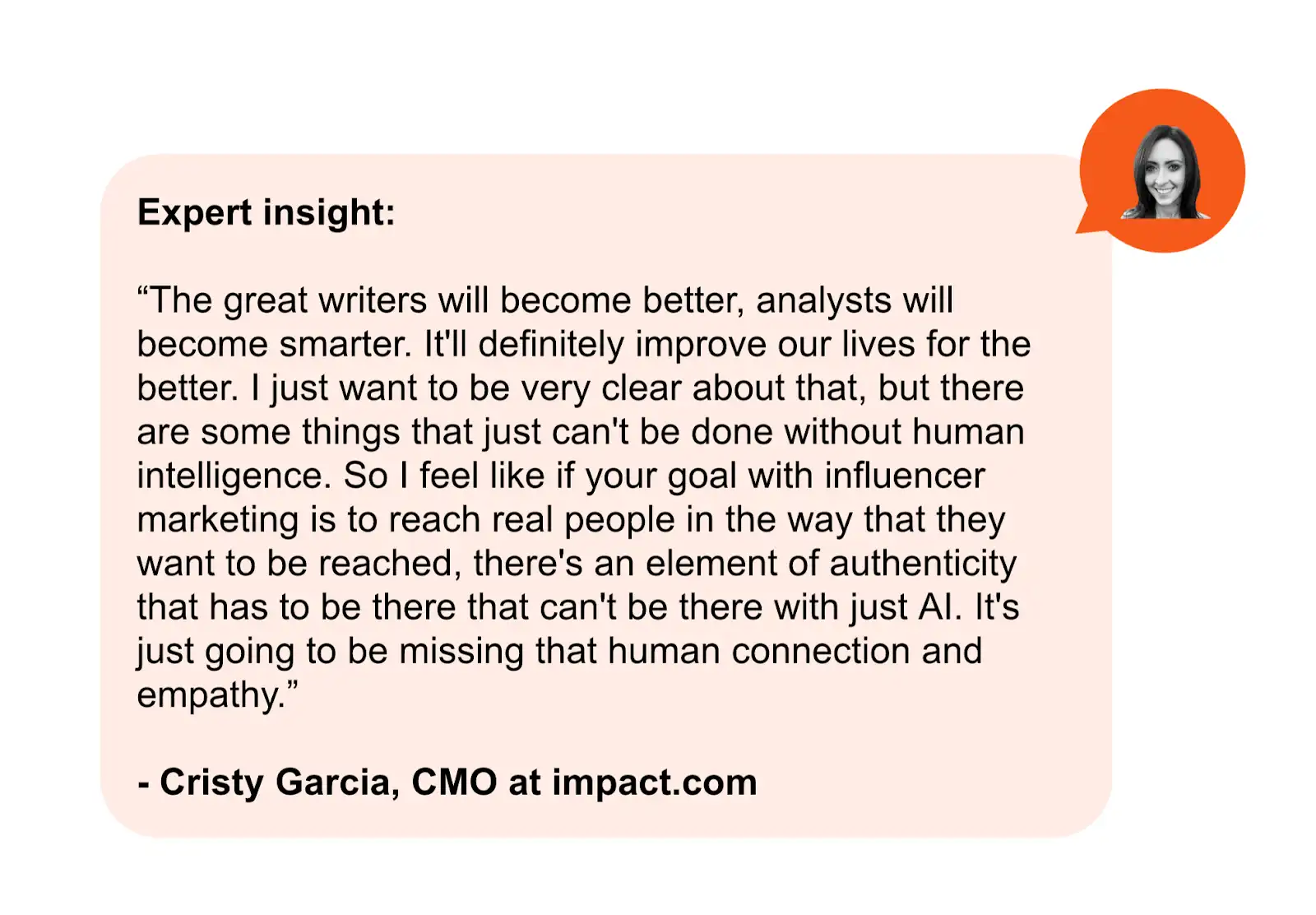
Opt for long-term vs. short-term creator partnerships
According to a Forrester report, the average business generates 18 percent of its revenue from paid search, while high-maturity partnerships programs contribute 28 percent of overall company revenue.
All marketers should aim for long-term partnerships. Collaborating with creators long-term helps you build trust with your target audience.
With a long-term partnership, influencers can publish a brand’s products more organically within their channels instead of posting a quick one-off image or video.
When your audience sees the same creators publishing content about your brand regularly, it shows that creators truly like what they’re showing the audience. Plus, people sometimes need to see something several times before they remember it.
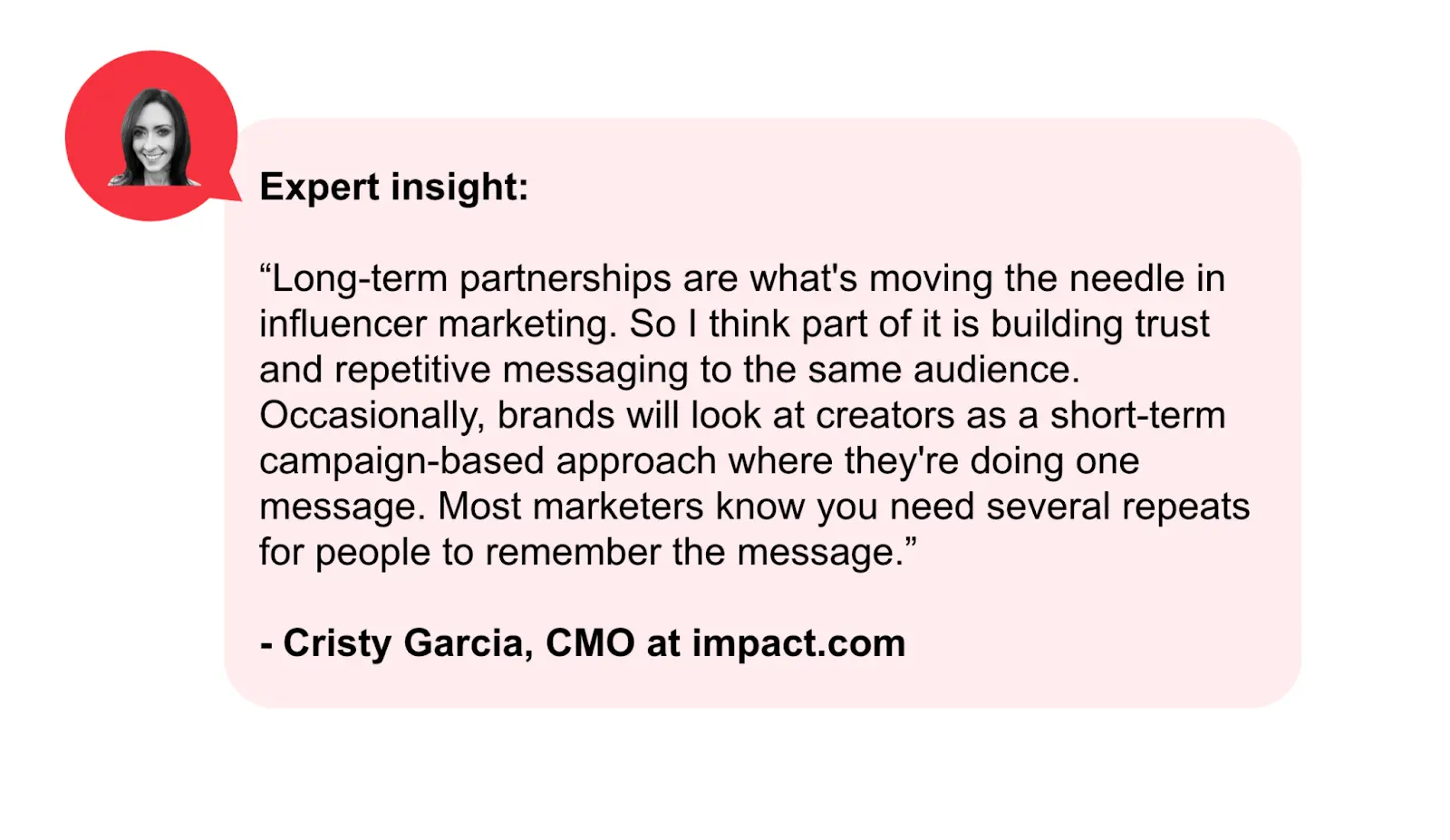
As an example, digital creator Jontá Harris has built a consistent partnership with the travel program Marriott Bonvoy. He curates regular Instagram feed posts and Stories, encouraging people to sign up for the program and collect points.
His posts aren’t a one-off ad for the travel program –– instead, they’re a blend of travel inspo, advice, and tips to help people make the most of what Marriott Bonvoy has to offer.

Source: @jontaoht
Even B2B brands can benefit from influencer marketing
Influencer marketing isn’t exclusively for business-to-consumer (B2C) brands—business-to-business (B2B) brands can also cash in. When brands partner with B2B influencers that align with their values, they can reach more target audiences, boost reputation, and drive sales.
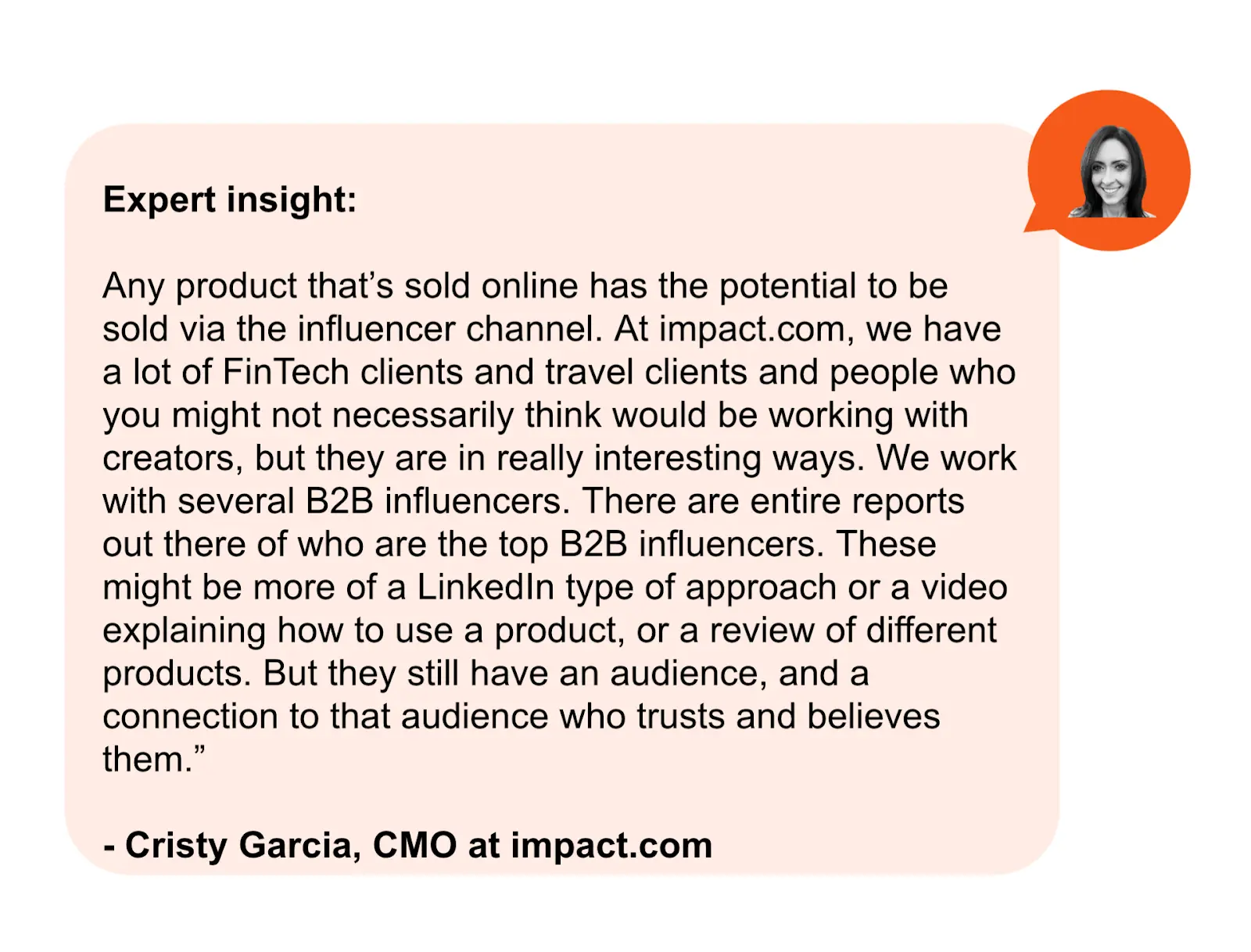
When brands work with B2B influencers, they can enjoy several benefits:
- Building trust: When people see an influencer they trust promoting your brand, it increases their trust in your brand and helps build credibility. The influencer’s credibility rubs off onto your brand.
- Winning loyal customers: Influencers often have a strong community of loyal followers who listen to their recommendations. When influencers successfully engage or convert their followers to your brand, the community will become loyal to your offering too.
- Reaching new audiences: Creators reach audiences you might not have had access to previously. If an influencer has a slightly different audience than yours, you can get your product in front of more potential customers.
A B2B influencer partnership that made complete sense
Customer experience software company Sitecore, partnered with B2B influencer Ann Handley to create a how-to guide that helps marketers create exceptional customer experiences. Ann hosted the event that launched the guide and posted the event on LinkedIn. While Sitecore has close to 100,000 followers on LinkedIn, Ann has almost half a million followers. This means Sitecore was able to reach a massive untapped audience.
Ann’s status as a best-selling B2B author and how she actively engages with followers means many marketers and businesses trust her recommendations. This makes her posts effective for boosting audience trust and brand awareness for Sitecore.
Tap into authentic influencer marketing to grow your audience and brand visibility
Influencers can get your brand in front of a larger target audience, build brand credibility, and boost your revenue. The secret is cultivating long-term partnerships with influencers who understand your brand and will promote it authentically. Taking the time to vet influencers and ensure they align with your brand values will help ensure success and a strong ROI.

Partnerships platform impact.com has everything you need to build and nurture long-lasting relationships with influencers. Discover, recruit, and collaborate with influencers in one place. Want to partner with influencers that deliver massive ROI? Learn more about setting up a successful influencer program.
Continue learning with these additional resources:
- Why brands should partner with UGC creators to build authentic connections [blog]
- Kick off your marketing program with influencers and affiliates [infographic]
- How the right content creator marketplace can supercharge your campaigns [blog]
- Influencer marketing in 2023: Three secrets to success [byline article]
- How to correctly compensate your influencers to beat the competition
- Customer testimonial: Savage X Fenty – Why use impact.com to manage your influencer program?
- Aligning marketers and influencers: Shifting perspectives on influencer marketing across the funnel [research report]
- Discover untold treasures in 7 successful influencer stories [ebook]
- How to set up a successful influencer program [worksheet]
FAQs about influencer marketing
What are the different types of influencers?
- Nano-influencer (fewer than 10,000 followers)
- Micro-influencer (10,000 to 49, 999 followers)
- Mid-tier influencer (50,000 to 99,999 followers)
- Macro-influencer (100,000 to 1 million followers)
- Mega-influencer (Over 1 million followers)
How do influencers get paid?
- Performance bonuses: brands pay influencers when a user triggers or converts an event. These events can include subscriptions, purchases, newsletter sign-ups, app downloads, and free trials.
- Participation bonuses: partners receive compensation for upper-funnel contributions such as brand awareness
- Hybrid model: creators are paid a flat fee plus performance and/or participation bonuses for specific user actions.
- Gifts: brands gift products or services to influencers in exchange for content creation.
- Flat fee: brands pay creators a fixed rate per post or campaign.
- Tiered fee: performance-based reward strategy that motivates affiliates to drive traffic, sales, or leads to move between compensation tiers
- Monthly payouts: influencers are paid a fixed monthly fee for the length of the cont
